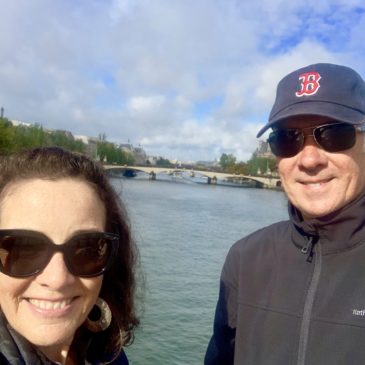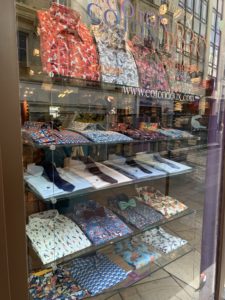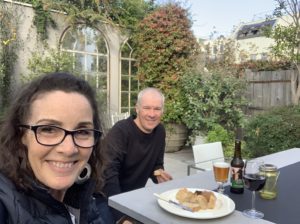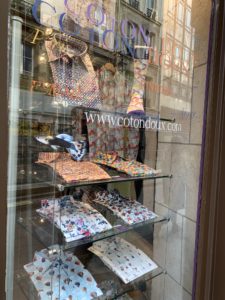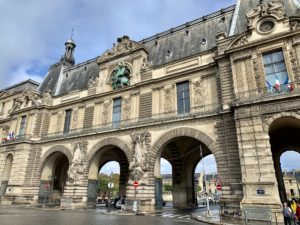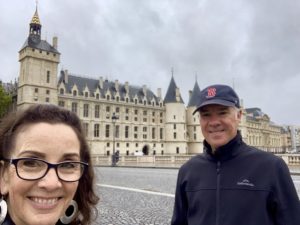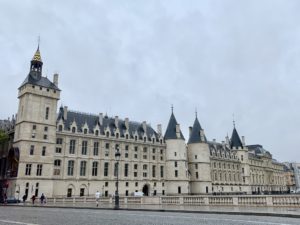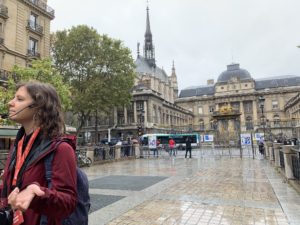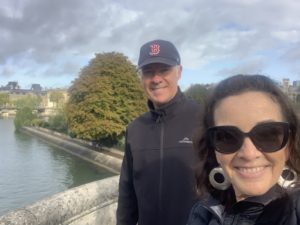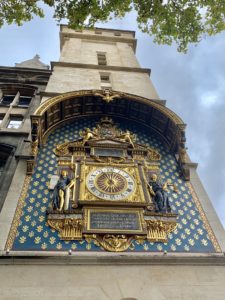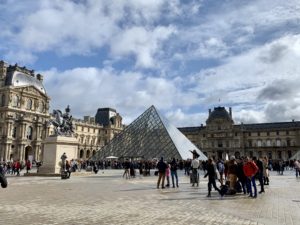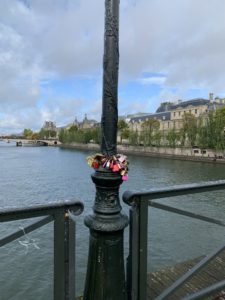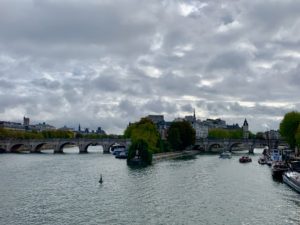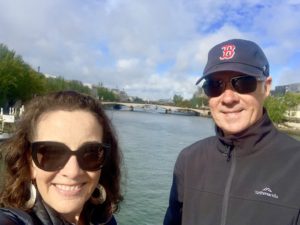Sunday 6th October
We’ve been a bit unlucky with the weather, especially here in Paris. It was another overcast morning but this time with rain before we set out. Our plan for the day was to take a 2 hour free walking tour of Paris in the morning, with Sandemans, and to smooch around the shops once they open; later in the afternoon given it’s Sunday.
The guide for our tour was a delightfully animated young Venezuelean girl, Michelle Alvarez, who had majored in art history and so she was perfect for guiding us through the streets of Paris pointing out key sites and key points of history. She was passionate about the subject matter and peppered her presentation with interesting anecdotes. For example, has anyone ever pointed out to you the asymmetry of Notre Dame and the reasons there of? See, point made!
Our 2.5 hour walk started at San Michele and went past the Palace of Justice, a few of the bridges, Notre Dame, the Louvre and finished up at the Jardin des Tuileries.
Other points I found interesting are noted in bullet form below:
- Napoleon 3rd, nephew of Napoleon Bonaparte, responsible for 19th Century Haussmann redevelopment of Paris. Prior was Medieval and chaotic and enabled the 1789 French Revolution due to the narrow streets. Redevelopment was for control reasons with wider streets. Some medieval buildings remain.
- Latin quarter: one of oldest part of Paris. Named after foundation of first University, the Sorbonne, in the area in 1270. Man responsible was the Kings Chaplain and wanted to make education available to everyone, not just the rich. The lessons were in Latin, hence called Latin quarter.
- Notre Dame:
- Started in 1163: took 192 years to build
- Architecture popular in period 500-1100 AD was Romanesque as this substantial and good for protection against invasion.
- People had feared the Year 1000 was going to be the end of the world and, when no harm came, they wanted to honour and thank God so developed the Gothic style and Notre Dame was built in this style.
- There are three key features of the Gothic style:
- 1 Taller building but, initially, these crumbled under the weight and so they developed ‘flying buttresses’.
- 2 Huge stained glass windows : these had two functions: to let light in and for education / induction via images for non readers.
- 3 Gargoyles: the word derived from the Latin meaning to ‘gargle’ as these structures diverted water, like gargling. Also, were to protect from evil spirits.
- Victor Hugo. Was a very significant in Notre Dames history:
- French Revolutionaries didn’t like Notre Dame as it embodied all things associated with the aristocracy and religion. There were 28 statues on the Facade of Notre dame and these were torn down and beheaded. The Revolutionaries thought they represented French Kings but they were actually biblical Kings! The statues there now are replacements.
- Cathedral was used for munitions storage during the French Revolution.
- Victor Hugo then wrote Hunchback of Notre Dame in 1831.
- This generated much interest in Notre Dame and many people came to visit.
- Thus, 13 years later, the building was renovated and restored.
- The left tower is wider than the right tower. This is not a mistake; it was intentional as trying to create symmetry and perfection was seen as arrogant. They were trying to honour perfection instead.
- Île de la Cité: was the heart of city and where the history began some 2,200 years ago. A Celtic tribe settled there as the island was easy to defend and had fresh water. This tribe was called the Parisis. Then, in 52 BC the Romans came / invaded. They named ‘lutece’ and this reference can be seen in some street names still today.
- St Chapelle: was built relatively quickly, 1238-1248, as Louis 9th has bought two holy relics: the Crown of Thorns and a piece of the Cross. They needed a home for these relics and so built St Chapelle inside Royal Palace for safety. The city then flourished financially due to all the pilgrims visiting the relics.
- Palaise de Justice: has been the seat of justice and power since Roman times.
- Palaise de Justice Clock: 1370. Oldest in city.
- Pont Neuf : means ‘new bridge’ but is actually the oldest. It was commissioned by Henry 4th; it was the first stone bridge to span both rivers.
- Louis 14 was the last King to live in the Louvre. He became King at the age of 4 years and survived a kidnap / murder attempt at 10 years of age. He commissioned Versailles in 17th Century to honour himself. This was a control strategy as well; so he knew where his nobles etc were.
- All of Paris monuments were booby trapped with bombs by Germans in WW2. Hitler ordered the setting off of the bombs but the allies had arranged for family of Hitler’s general to be rescued and so the General didn’t trigger the bombs.
- Pyramids at the Louvre: rumor has it that Francois Mitterrand made a ‘Captains call’ in selecting the Pyramid design in 1984 for the Louvre as he had an Egyptian mistress who had recently died and this was created in her memory. There are MANY different rumours though!
The tour finished at about 12.30 pm and so we headed to a cafe for lunch before browsing the shops. Mark managed to hold out until 3.30 pm for his first beer stop; an achievement!
It was another night of dining in as we’d had a big day with another planned for tomorrow; a day trip out to visit some Chateaus in the Loire Valley.
